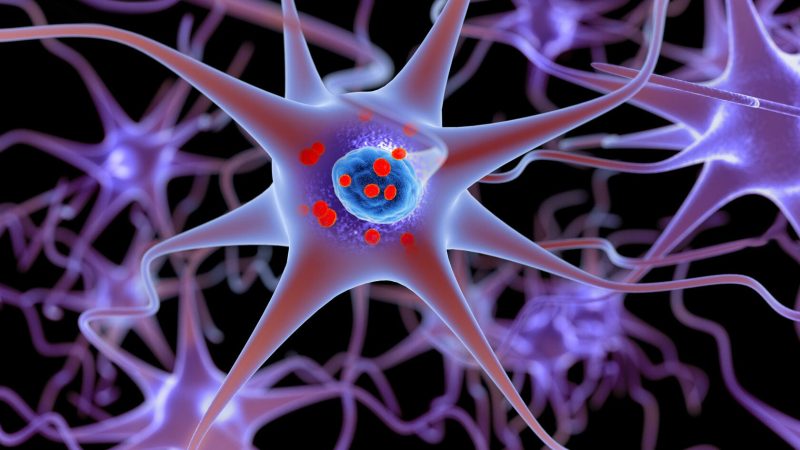A simple skin biopsy test has shown a high accuracy rate in detecting an abnormal form of alpha-synuclein, the pathological hallmark of Parkinson’s disease, according to neurologists at Harvard-affiliated Beth Israel Deaconess Medical Center.
In a paper published in the Journal of the American Medical Association, results from the landmark study, sponsored by the National Institutes of Health, validate this cutaneous method as a reliable and convenient tool to help physicians make more accurate diagnoses of Parkinson’s and the subgroup of neurodegenerative disorders known as synucleinopathies.
“While we have been aware of the presence of alpha-synuclein in cutaneous nerves for many years, we were thrilled with the accuracy of this diagnostic test.”
Roy Freeman, professor of neurology
“Each year, there are nearly 200,000 people in the U.S. who face a diagnosis of Parkinson’s disease, dementia with Lewy bodies, and related disorders,” said lead author Christopher Gibbons, a professor of neurology at Harvard Medical School and a neurologist at BIDMC. “Too often patients experience delays in diagnosis or are misdiagnosed due to the complexity of these diseases. With a simple, minimally-invasive skin biopsy test, this blinded multicenter study demonstrated how we can more objectively identify the underlying pathology of synucleinopathies and offer better diagnostic answers and care for patients.”
Affecting an estimated 2.5 million people in the United States, the synucleinopathies include Parkinson’s disease, dementia with Lewy bodies (DLB), multiple system atrophy (MSA), and pure autonomic failure (PAF). While the four progressive neurodegenerative diseases have varying prognoses and do not respond to the same therapies, they do share some overlapping clinical features such as tremors and cognitive changes. Additionally, all are characterized by the presence of an abnormal protein present in the nerve fibers in the skin called phosphorylated α-synuclein (P-SYN).
In this investigation, titled the Synuclein-One Study, Gibbons and colleagues at 30 academic and community-based neurology practices enrolled 428 people, ages 40-99 years, with a clinical diagnosis of one of the four synucleinopathies based on clinical criteria and confirmed by an expert panel or were healthy control subjects with no history of neurodegenerative disease. Participants underwent three 3-millimeter skin punch biopsies taken from the neck, the knee, and the ankle.
“These are systemic disorders that impact the peripheral and central nervous systems in profound ways,” said senior author Roy Freeman, director of the Center for Autonomic and Peripheral Nerve Disorders at BIDMC and professor of neurology at HMS. “While we have been aware of the presence of alpha-synuclein in cutaneous nerves for many years, we were thrilled with the accuracy of this diagnostic test.”
Among the participants with clinically confirmed Parkinson’s disease, 93 percent demonstrated a positive skin biopsy for P-SYN. Participants with DLB and MSA tested 96 percent and 98 percent positive, respectively. One hundred percent of participants with PAF were positive for the abnormal protein. Among the controls, just over 3 percent tested positive for P-SYN — an error rate the authors suspect may indicate some of the healthy controls are at risk for a synucleinopathy.
“Parkinson’s disease and its subgroup of progressive neurodegenerative diseases show gradual progression, but alpha-synuclein is present in the skin even at the earliest stages,” noted Freeman.
The team’s findings are built on earlier work by Freeman and Gibbons. The pair, together with immunohistochemist, Ningshan Wang, a research scientist at BIDMC and an assistant professor of neurology at HMS, have been focused on finding a reliable biomarker for synucleinopathies since 2009. Developing the research around alpha-synuclein in the skin is part of a licensing collaboration with CND Life Sciences, a neurodiagnostics company.
In 2023, the BIDMC researchers demonstrated and published in the journal Neurology that this technique could reliably distinguish between Parkinson’s and MSA, a differentiation that is critical to properly managing the diseases that appear clinically similar but have very different prognoses.
The authors anticipate that this research will play a role in accelerating drug development for synucleinopathies.
“Enrolling the right patients in clinical trials for these complex diseases is of utmost importance,” said Freeman. “Identifying the relevant biomarker in a patient and tracking it over the course of a clinical trial is an essential component of drug development in the neurodegeneration field.”
This work is supported by the National Institutes of Health (grants NIH R44NS117214) and sponsored by CND Life Sciences.





